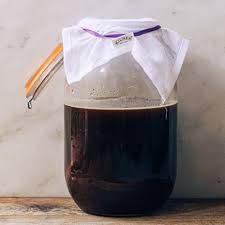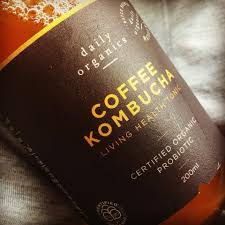Beginners guide to how to make Kombucha.
Here’s a beginner’s guide to making coffee kombucha for all you beginners out there. Let’s look at what it is and how to make and enjoy it. Kombucha is a fermented tea beverage that has gained popularity in recent years due to its potential health benefits. It is made by fermenting sweetened black or green tea with a culture of bacteria and yeast known as a “SCOBY” (symbiotic culture of bacteria and yeast). During the fermentation process, the yeast and bacteria in the SCOBY consume the sugar in the tea and produce various compounds, including organic acids, vitamins, and enzymes. This process gives kombucha its distinct tangy and slightly fizzy flavor.
Kombucha is often consumed for its potential probiotic properties, as it contains live bacteria and yeasts that are beneficial for gut health. These probiotics can help promote a healthy balance of bacteria in the digestive system. However, it’s important to note that the specific health benefits of kombucha are still an area of ongoing research, and individual experiences may vary. Commercially available kombucha products often come in various flavors, such as ginger, fruit-infused, or herbal blends. It is important to read the label and check the ingredients, as some commercial brands may contain added sugars or flavours.
While kombucha is generally considered safe for most people to consume, individuals with compromised immune systems, pregnant women, or those with certain health conditions may need to exercise caution or consult with a healthcare professional before incorporating it into their diet.

What does Coffee Kombucha taste like?
Coffee kombucha typically has a unique flavour profile that combines the characteristics of both coffee and traditional kombucha. It tends to have a tangy, slightly acidic taste, similar to regular kombucha, with a hint of natural sweetness. The coffee flavour adds a rich and robust undertone, offering notes of bitterness and earthiness. Depending on the brewing process and ingredients used, the taste can vary, but generally, coffee kombucha offers a balanced blend of kombucha’s tanginess and coffee’s distinct flavour.
- Kombucha is a fermented tea beverage that has been consumed for centuries. It is made by fermenting sweetened tea with a symbiotic culture of bacteria and yeast (SCOBY). The fermentation process produces a tangy, slightly fizzy drink with a unique flavor profile.
- Where does kombucha come from? The exact origins of kombucha are unclear, but it is believed to have originated in East Asia, possibly in China or Russia. Over time, kombucha spread to different parts of the world and gained popularity as a health beverage.
- Is kombucha healthy, and why? Kombucha is often considered a healthy beverage due to its potential probiotic benefits. Probiotics are beneficial bacteria that can support digestive health and boost the immune system. Kombucha also contains antioxidants, B vitamins, and small amounts of organic acids. However, it’s important to note that scientific studies on the health benefits of kombucha are limited, and individual experiences may vary.
- How does a beginner make kombucha? Here’s a simple step-by-step guide to making kombucha at home:
Step 1: Gather the ingredients and equipment. You’ll need a SCOBY, black or green tea bags, sugar, filtered water, a large glass jar, and a breathable cloth or coffee filter to cover the jar.
Step 2: Brew the sweetened tea. Boil a pot of water and add the tea bags. Steep the tea for 10-15 minutes, then remove the tea bags. Stir in the sugar until it dissolves. Let the tea cool to room temperature.
Step 3: Add the SCOBY and starter liquid. Place the SCOBY and some starter liquid (previously brewed kombucha) into the glass jar. The starter liquid helps kickstart the fermentation process.
Step 4: Ferment the kombucha. Pour the cooled sweetened tea into the jar with the SCOBY. Cover the jar with a breathable cloth or coffee filter secured with a rubber band. Place the jar in a warm spot, away from direct sunlight. Let it ferment for 7-14 days, depending on your taste preferences. The longer you ferment, the tangier and less sweet the kombucha will be.
Step 5: Bottle and flavor the kombucha. Once you’re satisfied with the taste, carefully remove the SCOBY and reserve some liquid as a starter for your next batch. Pour the rest of the kombucha into bottles, leaving some headspace. If desired, you can add flavorings like fruit juice or herbs to the bottles. Seal the bottles tightly.
Step 6: Second fermentation (optional). For added carbonation, you can do a second fermentation. Leave the sealed bottles at room temperature for 1-3 days. Remember to “burp” the bottles daily by slightly opening them to release excess pressure.
Step 7: Refrigerate and enjoy! After the second fermentation (if done), refrigerate the bottles to slow down the fermentation process. This will also enhance the flavor. Your homemade kombucha is ready to be enjoyed!

- Conclusion: Making kombucha at home can be a fun and rewarding process. It’s important to maintain cleanliness and follow proper brewing techniques to ensure a successful batch. Remember, fermentation can vary, so feel free to experiment with brewing times and flavorings to find your preferred taste. Enjoy your homemade kombucha in moderation as part of a balanced diet.
- Please note: If you have any specific health concerns or medical conditions, it’s best to consult with a healthcare professional before consuming kombucha.
Author.
Brendon McAliece is a multi-lingual expat who brings over three decades of flight simulator/PC building experience as well as over two decades of real-world jet fighter experience as a weapons/egress technician. He holds a sport pilot certificate giving him real-world flying experience. Hi travels have taken him from Europe to the Middle East, Asia and his home of Australia. He has a passion for travel, languages, Flight simulation as well as Guitaring and Coffee. You can read more in his blogs below.

Learn more @
DreamingGuitar.com – DreamingCoffee.com – LetsFlyVFR.com
Home – Blog – Shop – About
As an Amazon affiliate I may earn on qualifying sales.





